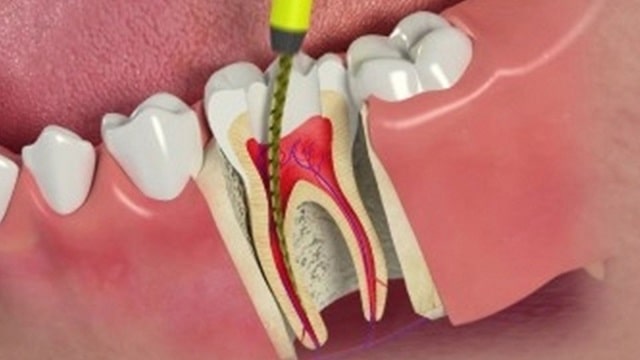Root Canal Treatment
Root canal treatment or endodontics is a procedure performed to treat damage to the tooth cavity. For example, irritated nerves and tooth pulp, inflamed teeth or gums, or infections due to deep decay, rough fillings, to cracks in the teeth.
It should be noted that the root canal is a cavity located in the center of the tooth. Where this cavity contains blood vessels and nerves. The nerves in the tooth cavity have no other function than the sensory function, which is to feel the hot or cold temperature of food.
Benefits of Root Canal Treatment
Root canal treatment is virtually painless and often causes less discomfort during recovery than a tooth extraction. Thanks to modern techniques and effective anesthesia, patients who have had a root canal are six times more likely to describe it as painless than patients who have had a tooth extracted.
When you have a root canal or other endodontic treatment, the inflamed or infected pulp is removed and the inside of the tooth is carefully cleaned and disinfected, then filled and sealed with a rubber-like material called gutta-percha. The tooth is then restored with a crown or filling for protection and will continue to function like any other tooth.
Purpose of Root Canal Treatment
Teeth have a soft core called dental pulp, which extends from the crown (the visible part of the tooth) to the tip of the root in the jawbone. The pulp contains nerves, blood vessels, and connective tissue. When a tooth is cracked, chipped, or has a deep cavity, bacteria can easily enter the pulp.
If left untreated, bacteria and decaying pulp can lead to serious infection or a tooth abscess. Injury to the tooth can also cause pulp damage, even if the tooth has no visible chips or cracks.
If pulp inflammation or infection is left untreated, it can cause pain or lead to an abscess. This means that root canal treatment aims to treat the inflamed or infected pulp, so as not to trigger serious complications.
When Should You Have Root Canal Treatment?
It is important to immediately check your condition to the dentist if you have a toothache, to ensure there is an infection in the tooth or not. This is because root canal treatment is needed when dental x-rays show that the pulp has been damaged by a bacterial infection. Symptoms of a pulp infection include:
- Pain when eating or drinking hot or cold food and drinks.
- Pain when biting or chewing.
- Loose teeth.
As the infection progresses, these symptoms often disappear as the pulp dies. As a result, the tooth appears to be healed, but the infection has actually spread through the root canal system. Eventually, this condition can potentially lead to further symptoms such as:
- Pain when biting or chewing again.
- Swelling of the gums near the affected tooth.
- Pus drains from the affected tooth.
- Swollen cheeks or jaw.
- The color of the teeth becomes darker.
Root Canal Treatment Procedure
Root canal treatment procedures are usually performed by an endodontist or general dentist. This treatment usually requires one or two visits. However, a person may need additional visits because in some cases, tooth decay proves difficult to treat. Gradually, this treatment procedure begins with the implementation of dental X-rays so that the doctor can determine the extent of the damage.
Then, the patient will be given local anesthesia so that the pain during the procedure can be reduced. Then, the doctor will place a rubber dam in the patient’s mouth. This aims to keep the teeth clean, protected, and free from saliva.
Next, the doctor will make a hole in the problematic tooth to create a path for the cavity and bacteria. Once the hole has been made, the tooth and cavity will be cleaned using a file inserted into the hole.
Afterward, the doctor will rinse the cavity after the tooth and the cavity are cleaned. To rinse it, the doctor will use a sodium hypochlorite solution or water to gargle. After the bacteria are removed, the root canal is filled and the tooth is covered with a filling or crown.
In most cases, the inflamed tissue near the tooth will heal naturally. Root canal treatment usually has a high success rate. About 9 out of 10 cases of teeth can survive up to 10 years after root canal treatment.
Places to Perform Root Canal Treatment
Currently, you can do root canal treatment in several places. Starting from community health centers (puskesmas), and dental clinics, to hospitals that have dental polyclinics. However, not all dental conditions require this treatment procedure.
Therefore, if you have a complaint about your teeth that does not get better, you should discuss it with your doctor first. Regarding what type of treatment is most appropriate to overcome your dental complaint.

